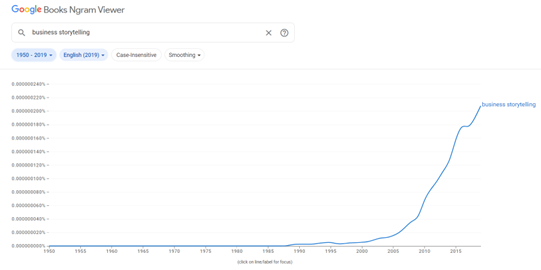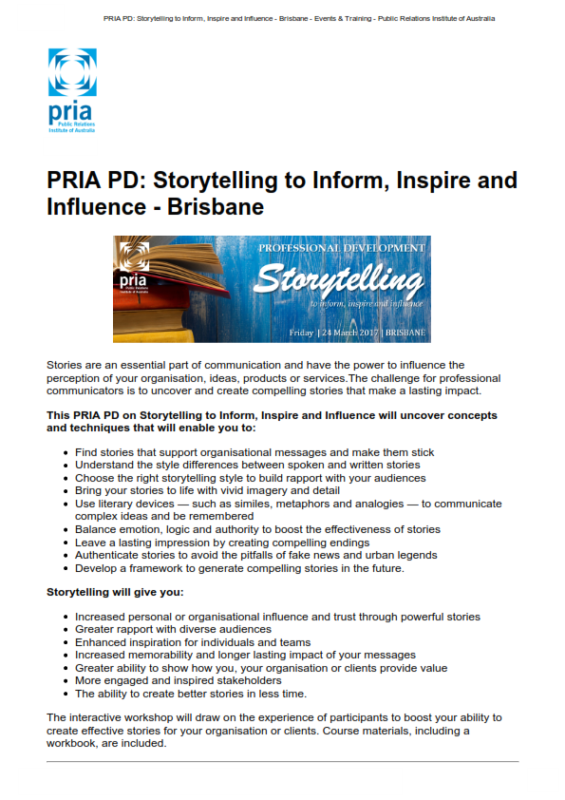As a long-time copywriter and speechwriter, business storytelling is part of my everyday life. Storytelling in business has always been a key part of persuading audiences, whether internal employees or external customers and prospects. But the term “business storytelling” didn’t come into prominence until the early 2000s. If look at Google’s Ngram Viewer (which measures how much a word is used in publications), interest in the subject started to take off around 2004.

Another important milestone was the release of The Leader’s Guide to Storytelling: Mastering the Art and Discipline of Business Narrative by Stephen Denning in 2007. Although many books and articles have been published since then, Dent’s is one of the best storytelling books for business.
Often, the power of storytelling in business is associated with the business leader who delivers a compelling story from the stage or online. But storytelling in business can take any form – from a case study on your website about one of your products or services to a company director presenting at an annual general meeting. So storytelling for business fits into the greater content marketing strategy of any business.
Here I’ll provide an overview of the art of storytelling in business – including business storytelling examples – based on years of experience as a business storyteller.
Creating great content for business storytelling
Although most people can tell a story in some form, creating great stories requires preparation and effort. Consider applying the following steps to create a good story.
Know your target audience – this will make a big difference in how you craft your story. If you’re speaking to an all-staff meeting, you will already know them so you don’t need to build trust as you would with a group that doesn’t know you. Also, not all audiences will know about your topic. For example, if you’re speaking to a younger audience and talking about your experiences in business (which can go back many years), you might need to include more explanation to provide context.
Determine your core message – once you know what your message is, find a story to back it up. Bill Gove, a legendary public speaking trainer, used to say, “Make a point – tell a story.” This can be a story from your experience or one you find somewhere else (online, in a book, etc.). But always make sure that the story is relevant to your message. One of my favourite business storytelling quotes is from Denning, who said: “Because we humans find stories such fascinating things, it’s all too easy to get interested in the story for its own sake, and lose sight of the purpose for which we set out to use the story.”
Include emotional elements – creating an emotional connection is a key reason for storytelling. Studies of the human brain show that we make decisions emotionally. For example, I wrote a case study about software that saves business owners a lot of time. As a result, they don’t have to work as long. When interviewing a customer (a business owner) for the case study, I found out that she could get home earlier and spend more time with her kids. Although I included the factual part about time saving, but focused on the emotional part of being able to leave work on time.
Include conflict and resolution – a great story needs conflict to get your readers or listeners involved. This is followed by a resolution to how things worked out in the end. For example, if telling a story about a customer, you can start with how they were dealing with a challenge. Tell a story of how your product or service solved their pain points. Show the customer as the hero. If you’re not familiar with the hero’s journey it’s a model for storytelling that’s been used for thousands of years, and you can apply to your brand story with some planning and effort.
Keep you story short – once you understand storytelling techniques, it can be tempting to create a long story. But as Denning points out in The Leader’s Guide to Storytelling, a minimalist story is often the best approach. With busy lives and so many distractions, the trend is to keep it short. For example, traditional keynote speeches used to run between 40 and 60 minutes. More recently, formats such as TED Talks are under 20 minutes.
Perfect for storytelling in business
If you’re delivering your story in a speech or presentation, practice your story to make sure it comes off without a hitch. That being said, you can use the business storytelling framework in any format – written, video, podcast, etc.
Become a story collector to draw from when you need to share stories in business. When you read or hear stories that you can use in business, write them down. Also bookmark websites where you find the best stories. You can even print out hard copies and keep a physical file the you can access when you need the right story for an event or other format.
Include a strong call to action. Several years ago, I wrote a keynote speech for a man who suffered from a horrific industrial accident. A big part of his speech was the story of how he was injured and his long road to recovery. His call to action was for his listeners to adopt safe work processes to avoid having to go through the pain and suffering of being injured at work.
Keep up by reading business storytelling books. You can start with Denning’s book (one of the best books on storytelling in business) and also take a business storytelling course to enhance your business storytelling skills.
Looking for business storytelling training?
As a long-time business storyteller, I deliver business storytelling workshops across Australia. These are customised to each organisation’s needs. For example, I provided business storytelling training to members of the Public Relations Institute of Australia (PRIA) in Melbourne, Brisbane and Perth. In my business storytelling workshops, I teach business storytelling techniques from experience writing stories for all types of organisations – from SMEs to Global Fortune 100 companies. With interaction and gamification, my business storytelling workshops are fun with plenty of applicable techniques to apply right away.
Here’s the promotional content from the storytelling workshop I delivered for The Public Relations Institute of Australia.

If you are considering a business writing and storytelling course for your business, I’ll be glad to discuss your requirements in detail. Please call me on 1300 731 955 or use the contact form (Get In Touch) on this page.


